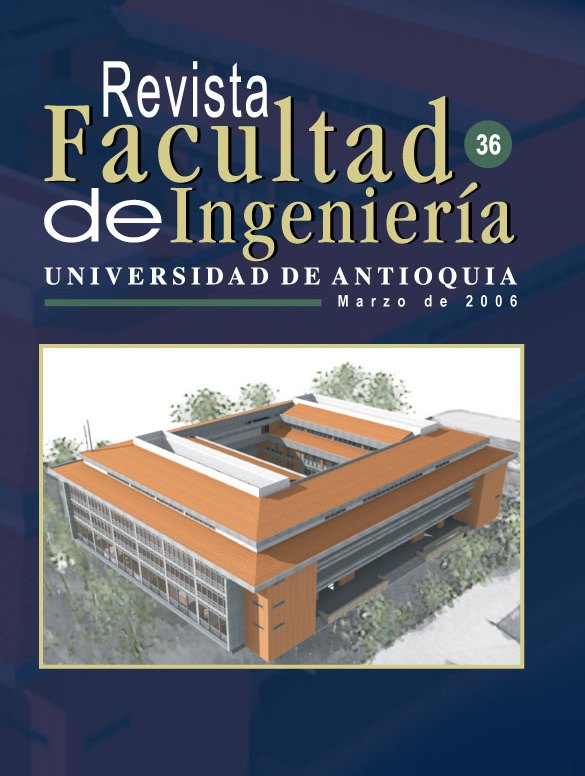Uso de un aditivo biológico para mejorar las propiedades físico-mecánicas y térmicas del hormigón
DOI:
https://doi.org/10.17533/udea.redin.343263Palabras clave:
biorrefuerzo, porosimetría, conductividad térmica, bacterias calcificantes, durabilidadResumen
Se utilizó un aditivo biológico compuesto principalmente por bacterias calcificantes (T. ferroxidans, T. thioxidans, Desulfovibrio y Sulfolobus acidularios) en una mezcla de hormigón. El aditivo se sintetizó a partir de cepas nativas con un medio nutritivo (medio 9 K modificado), 2,5 ≤ pH ≤ 3,0 a temperatura ambiente en un bioreactor de 30 L. Con el fin de determinar la factibilidad técnica se prepararon cilindros de hormigón con 30, 60, y 100% de aditivo biológico para 2 edades (7 y 28 días.), se utilizaron mezclas 1:2,3:3 (para la relación cemento: arena: grava) y una relación agua: cemento de 0,56:1. La muestra sin aditivo biológico se usó como patrón. La resistencia aumentó 17,2 % para la muestra con 30% aditivo biológico (14,63 ± 2,11 MPa y 15,17 ± 0,85 MPa a los 7 y 28 días. respectivamente); el porcentaje y el diámetro de poros disminuyó en 39 y 46%, respectivamente para 30% de aditivo biológico (0,91% de poros y diámetro de poro de 144,7 µm); el coeficiente de conductividad térmica disminuyó en todas las muestras con aditivo biológico. La mejor dosificación fue la de 30% que disminuyó el coeficiente de conductividad térmica en un 50% (0,33W/m K). La probeta patrón fue desfavorable frente el ácido nítrico, presentando una mayor pérdida de peso promedio (0,464 ± 0,012 g), mientras que la pérdida de peso de la probeta con 30% de aditivo biológico fue 0,326 ± 0,028 g.
Descargas
Citas
R. Santhosh K. et al. “Remediation of concrete using micro-organisms”. ACI Materials Journal. Vol. 98. N.o 1. 2001. pp. 3-9. DOI: https://doi.org/10.14359/10154
P. Lanoy. “Bacterias en las rocas”. Revista Muy Interesante. Vol. 9. N.o 99. 1993. pp. 60-63.
F. Lemarchand. “Un ‘lifting’ bacteriano contra el envejecimiento de las piedras”. Revista Mundo Científico. Vol. 15. N.o 160. 1995. p. 779.
Programa integrado para la mejora de los suburbios, Medellín, Colombia, Germán D. Gómez V. En: http://habitat.aq.upm.es/dubai/00/bp540.html. Consultada el 5 de junio de 2005.
M. González M., N. Ben O. and M. Arias J. “Biomineralización: revisión de algunos de sus aspectos mas destacados”. Ars Pharmaceutica. Granada. Vol. 37. N.o 3. 1996. pp. 483-518.
´[6] Instituto Colombiano de Normas Técnicas. N.os 32, 78, 110, 112, 117, 118, 119, 120, 121, 184, 220, 221, 224, 225, 385, 396, 397, 454, 489, 490, 491, 550, 663, 861, 890, 1.085, 1.299, 1.377, 1.513, 1.977, 4.025. Bogotá D. C. 1992.
¨[7] American Society for Testing and Materials. N.os C-177, C-217, C-241, C-457, C-642. Philadelphia. 1987.p.
K. Simkiss and K. M. Wilbur. Biomineralization, cell biology and mineral deposition. Academic press, Inc. San Diego, California. 1989. p.
H. A. Lowenstan and S. Weiner. Biomineralization. Oxford University Press. New York. 1989. p. 324.
D. Jones and M. J. Wilson. Biomineralization in crustose lichens. Clarendon Press Oxford. 1986. pp. 91-105.
Propiedades mecánicas del hormigón. http://www.construir.com/CIRSOC/DOCUMENT/datos3.htm. Consultada el 8 de octubre 2003.
J. F. Mesa H. Caracterización de poros en carbones tratados térmicamente empleando técnicas de procesamiento digital de imágenes y microscopia asistida por computador. Notas del profesor. Laboratorio de metalografía. Universidad Nacional de Colombia sede Medellín. Medellín. 2000.
B.V. Karlekar. Transferencia de Calor. Madrid. 2.a ed. McGraw-Hill. 1994. p. 10.
G. W. DePuy. “Chapter 26: Chemical Resistance of Concrete”. Significance of Tests and Properties of Concrete and Concrete-Making Materials. ASTM STP 169C. American Society for Testing and Materials. Philadelphia, PA. 1994. pp. 263-281.
E. Hincapié Atehortúa y S. Moreno Rojas. Patologías de las fachadas revestidas en piedra arenisca, esquisto y mármol en la ciudad de Medellín. Trabajo Dirigido de Grado Ingeniería Civil. Universidad Nacional de Colombia sede Medellín. Medellín. 2001. p. 80.
O. Giraldo Bolívar. Guía práctica para el diseño de mezclas de hormigón. Universidad Nacional de Colombia sede Medellín. Medellín. 1993. p. 30.
J. C. Pérez R. y Juan F. Ramírez. Biolixiviación aplicada a un material aurífero refractario. Trabajo de Grado para optar al título de ingeniero químico. Universidad Nacional de Colombia sede Medellín. Facultad de Ingeniería. Medellín. 1998. p. 50.
C. R. López. Características mecánicas del hormigón armado. En: http://fing.uncu.edu.ar/catedras/archivos/hormigon_i/MATERIALES.pdf. Consultada el 10 de enero de 2002.
A. Demain y N. Solomon. “Manual of Industrial Microbiology and Biotechnology”. American Society for Microbiology. Washington D. C. 1986. pp. 18-20.
Vitrocerámicos. http://www.unan/.mx/publicaciones/ciencia-unanalgoritmo.pdf. Consultada el 6 de enero de 2003.
Jarosita, Thiobacillus Ferroxidans. http://www.unmsm.edu.pe/biology/reunion/7r-bt01.htm. Consultada el 10 de enero 2002.
J. I. Ruiz M. y D. A. Jiménez C. Bio-refuerzo de hormigón. Trabajo de grado para optar al título de ingeniero químico. Universidad de Antioquia, Facultad de Ingeniería. Departamento de Ingeniería Química. Medellín. 2003. p. 45.
Descargas
Publicado
Cómo citar
Número
Sección
Licencia
Los artículos disponibles en la Revista Facultad de Ingeniería, Universidad de Antioquia están bajo la licencia Creative Commons Attribution BY-NC-SA 4.0.
Eres libre de:
Compartir — copiar y redistribuir el material en cualquier medio o formato
Adaptar : remezclar, transformar y construir sobre el material.
Bajo los siguientes términos:
Reconocimiento : debe otorgar el crédito correspondiente , proporcionar un enlace a la licencia e indicar si se realizaron cambios . Puede hacerlo de cualquier manera razonable, pero no de ninguna manera que sugiera que el licenciante lo respalda a usted o su uso.
No comercial : no puede utilizar el material con fines comerciales .
Compartir igual : si remezcla, transforma o construye a partir del material, debe distribuir sus contribuciones bajo la misma licencia que el original.
El material publicado por la revista puede ser distribuido, copiado y exhibido por terceros si se dan los respectivos créditos a la revista, sin ningún costo. No se puede obtener ningún beneficio comercial y las obras derivadas tienen que estar bajo los mismos términos de licencia que el trabajo original.










 Twitter
Twitter